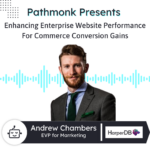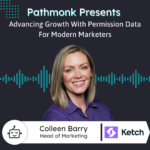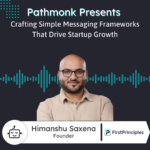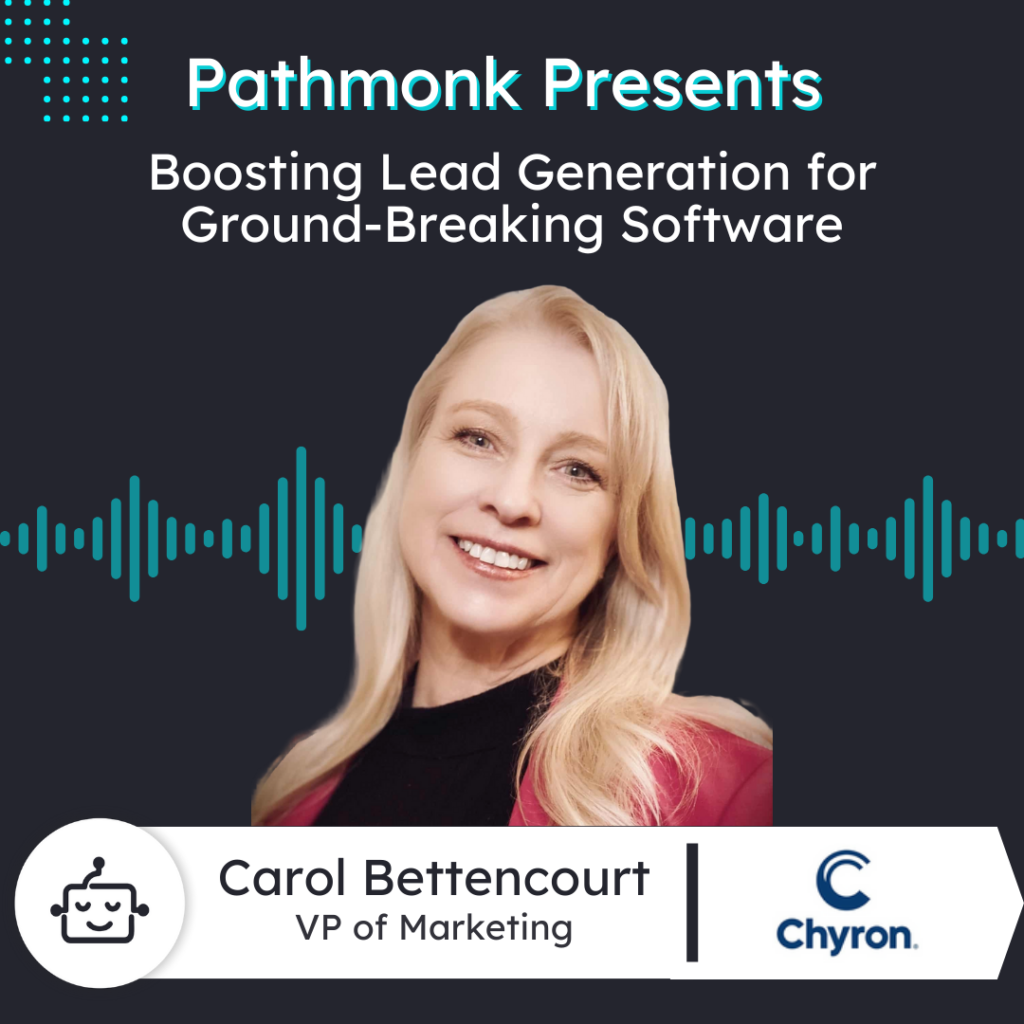
Introduction
With this insightful discussion, Carol Bettencourt shares how Chyron helps broadcasters maintain viewer engagement and streamline workflows, ensuring they stay competitive in a challenging market. She also reveals strategies for leveraging your website to convert visitors into leads, emphasizing the importance of a well-thought-out web journey and relevant content.
Don’t miss out on Carol’s expert advice on building a high-performing marketing team, staying current with industry trends, and the crucial role of continuous learning. Tune in to unlock actionable insights that can transform your marketing efforts and drive your business forward.
More Sales From Your Website With AI
Personalized interactions based on your users' behaviour to get +50% more conversions.
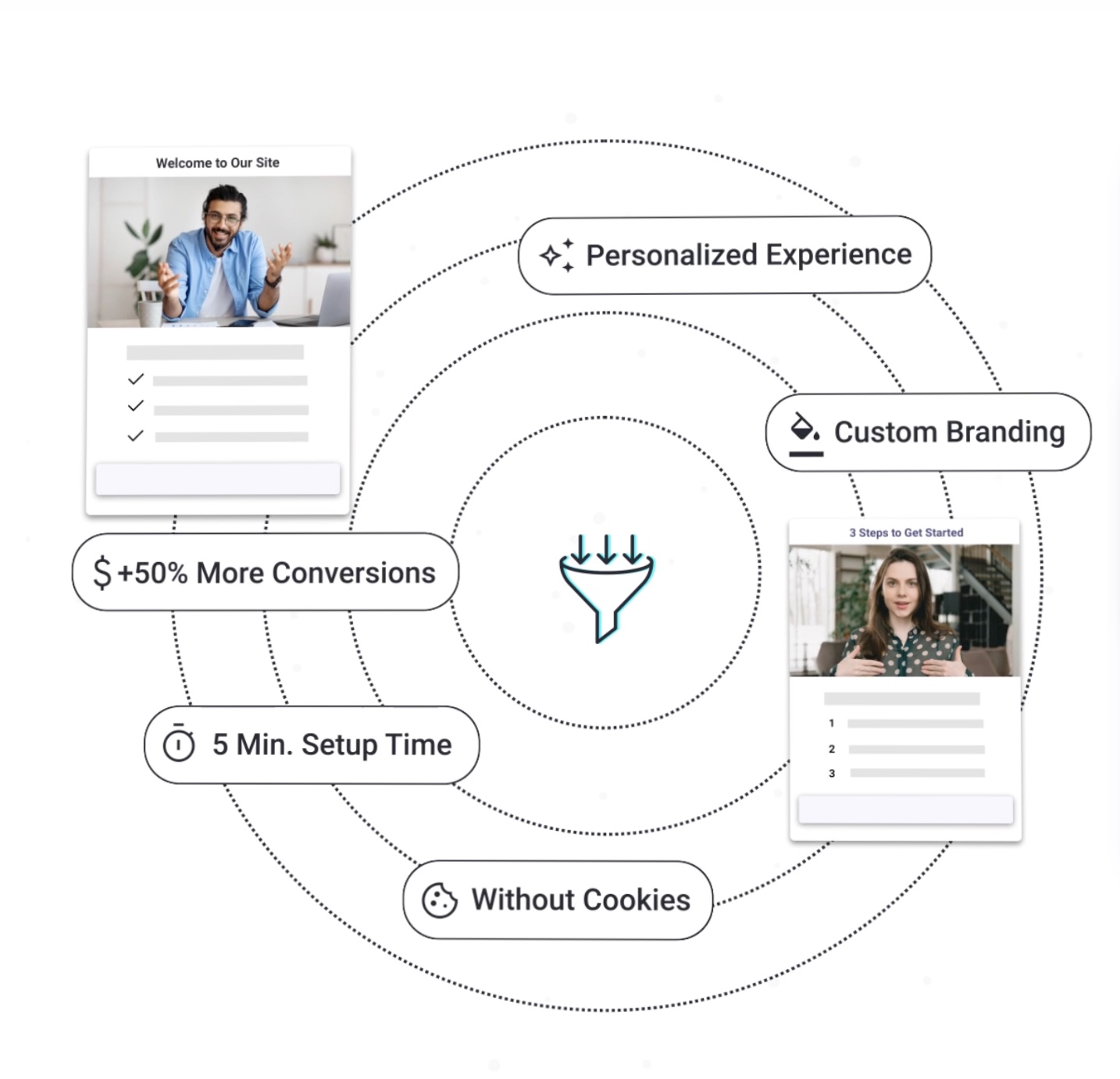
Ernesto Quezada: Pathmonk is the intelligent tool for website lead generation. With increasing online competition, over 98% of website visitors don’t convert. The ability to successfully show your value proposition and support visitors in their buying journey separates you from the competition online. Pathmonk qualifies and converts leads on your website by figuring out where they are in the buying journey and influencing them in key decision moments. With relevant micro experiences like case studies, intro videos, and much more, stay relevant to your visitors and increase conversions by 50%. Add Pathmonk to your website in seconds. Let the AI do all the work and get access to 50% more qualified leads while you keep doing marketing and sales as usual. Check us on pathmonk.com. Welcome to today’s episode. Let’s talk about today’s guest. We have Carol from Chyron, VP of marketing there with them. How you doing today, Carol?
Carol Bettencourt: I’m doing great. Thank you so much for having me on. This is going to be fun.
Ernesto: Perfect. Awesome. Well, let’s kick it off, right? I’m sure our listeners are tuning in, wondering what Chyron is all about. So, in your own words, tell us a little bit more.
Carol: Well, some of them, if they’re involved at all in the broadcast industry, they may have heard of Chyron. Chyron is the company who invented in the sixties the technology that puts digital graphics over live-to-air video. So if you’re watching television and it’s live and there’s a camera feed, you typically see the sporting event or the anchor, the reporter. Sports and news are what is most commonly watched live. But you may also see other things. You might see somebody’s name down here. You might see a little promo pop-up. You might see a station identification. Previously, none of that was possible, except only in a very rudimentary way where people cut out letters and filmed them and put that over the video. But we invented that technology. In fact, even today, whether it’s text or graphics generated by our devices or by a competitor’s devices, you might hear it generically referred to as the chyron, much the same way that Kleenex might be used to refer to a facial tissue. So we’re very proud of that history of innovation, and we continue to innovate today.
Ernesto: All right, awesome. Great to hear that. And then so on that note, so that way our listeners can get a good understanding of Chyron, what would you say is the key problem that you guys like to solve for your clients?
Carol: Well, our clients are in a very challenging industry. There are millions, if not billions, of eyeballs in front of their work every day. They can’t go dark on air. It’s very competitive. They need to maintain viewership to get those advertising dollars. So we want to make everything just right for them. We want to make things exciting for their viewers and want to streamline their workflow so that they can stay efficient while also helping them monetize and make more money. So today, it’s not just those graphics, but it’s simpler workflows. It’s automating things, it’s infusing things with data. Data, whether that’s election data, sports data, weather data, any other kind of data that helps them tell their story, as well as finding ways to make things simpler.
Ernesto: Very great to hear that. So then, I mean, I don’t want to assume here, but would that be the vertical segment that you guys like to go for, or are there other verticals that you guys like to go for?
Carol: There are about nine verticals, I think, on our website, and some would fall into that category of being a traditional broadcaster. There’s news broadcast, there’s sports broadcast, and along with those, there’s anything else that might be broadcast live, an event, a film, a show that happens live. But there’s also, within a venue, we can use the same technology to power in a stadium, the center halls, the ribbon boards, jumbotrons, or whatever other brand might be used at the ends of the field, any in-venue displays. Other verticals would include esports. That’s an emerging vertical that entails both live broadcast and also an in-venue experience. Education, where students are learning to be broadcasters, it’s important for them to recreate the same final workflow, the same final control room environment. Corporations, especially very large corporations who want to do their own broadcasting both internally and externally, and then even longer tail, anyone who has a social channel where they might do live feeds, but they want to recreate that broadcast-grade feel. So really, today, anybody can become a broadcaster, and that really opens up all kinds of verticals for us.
Ernesto: Definitely important. Great to hear that. So then, how would somebody usually find out about Chyron? Is there a top client acquisition channel for you guys?
Carol: Well, there are some existing channels that we rely on, but we’re always exploring new ways to reach people who might use our technology. One answer to your question, the lazy answer, but it’s not entirely untrue, would be, oh, they just know. And if you’re talking about a major network, it’s true, they do just know. But we also have a strong presence at industry trade shows and in trade publications. Our website gets good traffic and good Google ratings. We do have a robust social media presence. But we’re looking into some of those longer-tail specifications. Sports publications, especially with the ever-changing rights holder landscape, get to broadcast things. Is it the team? Is it the league? Is it who’s purchasing the rights? Is it individual players? So we’re looking for more and more ways to reach whoever might be a customer. That aspect of our business is as ever-changing as the technology itself.
Ernesto: Great to hear that. So then on that note, so that way our listeners could go ahead and visit you guys. They could always check you out at chyron.com. What role does the website then play for client acquisition?
Carol: Well, I think a website is very important in any business, and it certainly is important for our business. Even though I mentioned there are those who just know, it’s important to have a place for them to land to come see what the latest technology is, what the latest release is, what key features have been added. It’s also a place for those who are searching, who don’t just know. Again, we do rank fairly high on SEO. It’s also a way for us to build that funnel process. There is the initial place where you can land on our website. And every page carries you through a journey. Here’s a quick video. Here are some key advantages. And then down lower, you can get more involved with the product information sheet. So gated content. Contact us now. So we try to take people through a journey on every single page on our website. And it is a tool for us to collect leads. Again, as I mentioned, there’s a lot of gated content there.
Ernesto: Awesome. And so then on that note, Carol, is there any tools or tips or methods that you would recommend to our listeners as far as some website lead generation?
Carol: I think it’s important to think about what you want your website to do. Sometimes people just throw up a website because they want to put their phone number or a button, or sometimes they get very involved in the artistry of the website. And that is important. It’s important to have a good-looking website that represents your brand. We’ve all seen how successful Apple is because everything they do is so polished and on point. So that part is important. But I think step one is to really think about what you’re trying to say, what you’re trying to accomplish, where your potential users are right now, and what they’re going to want to know so that when they get to your website, it’s not only impressive, it’s easy to follow, and it takes them on the journey that you want them to take and meets them where they are.
Ernesto: Awesome. Thank you so much for sharing that, Carol. Well, let’s switch gears a little bit, and let’s talk about you as a leader. You being the vice president of marketing there, Carol, for Chyron, what are some key tasks you like to focus on in your day-to-day work?
Carol: Well, I’m very fortunate. I have had the privilege of building my team from the ground up. I was asked to clean house and start from scratch and build a team and mentor the team. So my key day-to-day task is to make sure they all have what they need and they’re all aware they should be. And if they’re not where they should be as far as their tasks, to find out why and to help them move along. We have an art director, we have a social media team, we have an operations manager who also manages tracking the performance of everything that we do. We have a product marketing team that creates all of our product-related content, does our competitor research, defines the key selling points, and creates things based on those key selling points. We have someone who’s an industry expert, manages most of our technology partnerships, our channel partnerships, and partnerships with key customers before we pass those along to the sales team. So my job is to make sure that they’re all on track, have what they need, and that we’re all aligned, working towards the common goal.
Ernesto: Great to hear that on your day-to-day, Carol. And so, in the between times, is there a preferred channel where you’d like to stay up to date with all the marketing news, trends, strategies?
Carol: There are so many. I wish I had the luxury of just reading things all day or talking to people all day, but I do try very hard to keep up with my industry, to keep up with marketing best practices, advertising best practices, and what our customers are doing. So I’ll typically look through my emails, and I get notifications from the key trade publications, TVTech in broadcast, the International Association of Broadcast Manufacturers, the National Association of Broadcasters, SIMTI, which is a technical standards organization. And I’ll try to at least scan the headlines and see what pops out and skim or read as much as I can. I generally keep up with the Harvard Business Review. I find that’s an excellent source of advice for managing your team and also relating to the upper management and our board in our company. I’ll read magazines such as Wired for general tech trends. I’ll read the Wall Street Journal. I subscribe to Adweek. So I do love to read, and I try to soak in as much as I can. I think the world is not just technology, but the world is always changing, whether it’s martech, adtech, or technology that we make. So there is a lot to keep up with, and it’s important not to rest on your laurels, not to rest on your past knowledge. You can build on what you already know, but I really think it’s important to never, ever, ever stop learning.
Ernesto: Absolutely important. Thank you so much for sharing that with us, Carol. And we’ll just jump into our next section then here, Carol, which is our rapid fire question rounds. Are you ready for them?
Carol: I think so.
Ernesto: All right, perfect. First off, Carol, what is the last book that you read?
Carol: Well, I have a horrible habit of reading multiple books at the same time. So the last ones that I were reading all at the same time. I’ll give you three. “Extreme Ownership.” It’s by a former Navy SEAL named Jocko Willink and Leif Babin. And it’s really about taking accountability. When things go wrong, it’s easy to blame. And you might be right in your blaming, but that doesn’t solve anything. And this book really drove that point home about building those alliances and getting ever better at communicating what it is that you need and what you think needs to happen. “The Creative Habit” by Twyla Tharp, who is a world-class modern dancer, choreographer, and director. I’ve often had people remark on how unusual I am in that I employ the right brain and the left brain, but I think those two really go together. I think you can solve technical problems with creativity, and you can solve creative problems with logic and common sense. So I really embrace that book. And then the last one that I’ll mention is called “For New Managers.” It’s by Harvard Business Review, and I use that to mentor people on my team who have other reports underneath them. It’s a collection of case studies, and we have a monthly book discussion.
Ernesto: Okay. All right, awesome. Great set. Next up then, if there would be no boundaries in technology, what would be that one thing that you want to have fixed for your role as a marketer today?
Carol: The bane of my existence, because I do try to prove what we’re doing and the value of what we’re doing, and I do try to sort out what could be better. I’m always looking for data. The bane of my existence as a marketeer at this point in my career is attribution modeling. And if there was a foolproof way to attribute what finally led to a sale, and in our industry, there’s typically, on average, an 18-month cycle before someone buys after they become interested. And if I could sort out what to attribute that to many touchpoints that they engage in on that journey, that would be golden. I don’t think there is such a thing, though.
Ernesto: All right. And lastly, Carol, I mean, you have a lot of experience already in the marketing world, but what is that one piece of advice that you would give yourself if you were to restart your journey as a marketer today?
Carol: That’s a great question. Thanks for asking. Two things. I would say be more strategic in building alliances, and that’s what I would tell myself. Maybe other people already are. I think of myself as a problem solver, and I, at certain points in my life and in various aspects of various careers that I’ve had, I keep my head down. I get the job done, and as a leader, I mentor others, and they get the job done. But that’s not all there is to it. If you’re part of an organization and that organization is part of an industry, there are so many people who can help you, and whose buy-in you may need to get done what you want to do. So I would say be very strategic and very intentional about building alliances. And the second thing, as somebody is coming out through any industry, they’re trying to prove yourself. The impulse is to say yes to things to impress people. But I would also tell people, please consider saying no. Sometimes you have to. Your time is valuable. So be mindful of what you say yes to.
Ernesto: I would definitely agree with that. I mean, as a young person, I would say yes to everything to try to be in everybody’s good grace, but definitely time is valuable, so learn to appreciate that.
Carol: Absolutely.
Ernesto: Awesome. Well, Carol, it’s been a pleasure to have you on today’s episode here with us. But before we do end, I do want to give you the last word. If someone forgets everything about the interview today, what is that one thing they should remember about Chyron?
Carol: About Chyron, I would say that Chyron is a legacy brand, but it’s had its ups and downs, and in many aspects today, it is almost like an entrepreneurial startup. It’s a big, giant entrepreneurial startup. And in many ways, there’s a whole history behind what we do. So if anybody is part of a business or is starting a business or has had a business for a long time, I would say always look for your next way forward. Even if it seems like you’ve come up against a wall, there’s more to be done. The future is there. And don’t stick with any past failures, but build on past successes.
Ernesto: Definitely important.
Carol: Absolutely.
Ernesto: Awesome. Well, Carol, thank you so much for being on. I do want to thank our listeners as well for tuning in with us today, and I’m looking forward to our next episode at Pathmonk Presents. Thanks a lot, Carol.
Carol: My pleasure. Thanks for having me.




